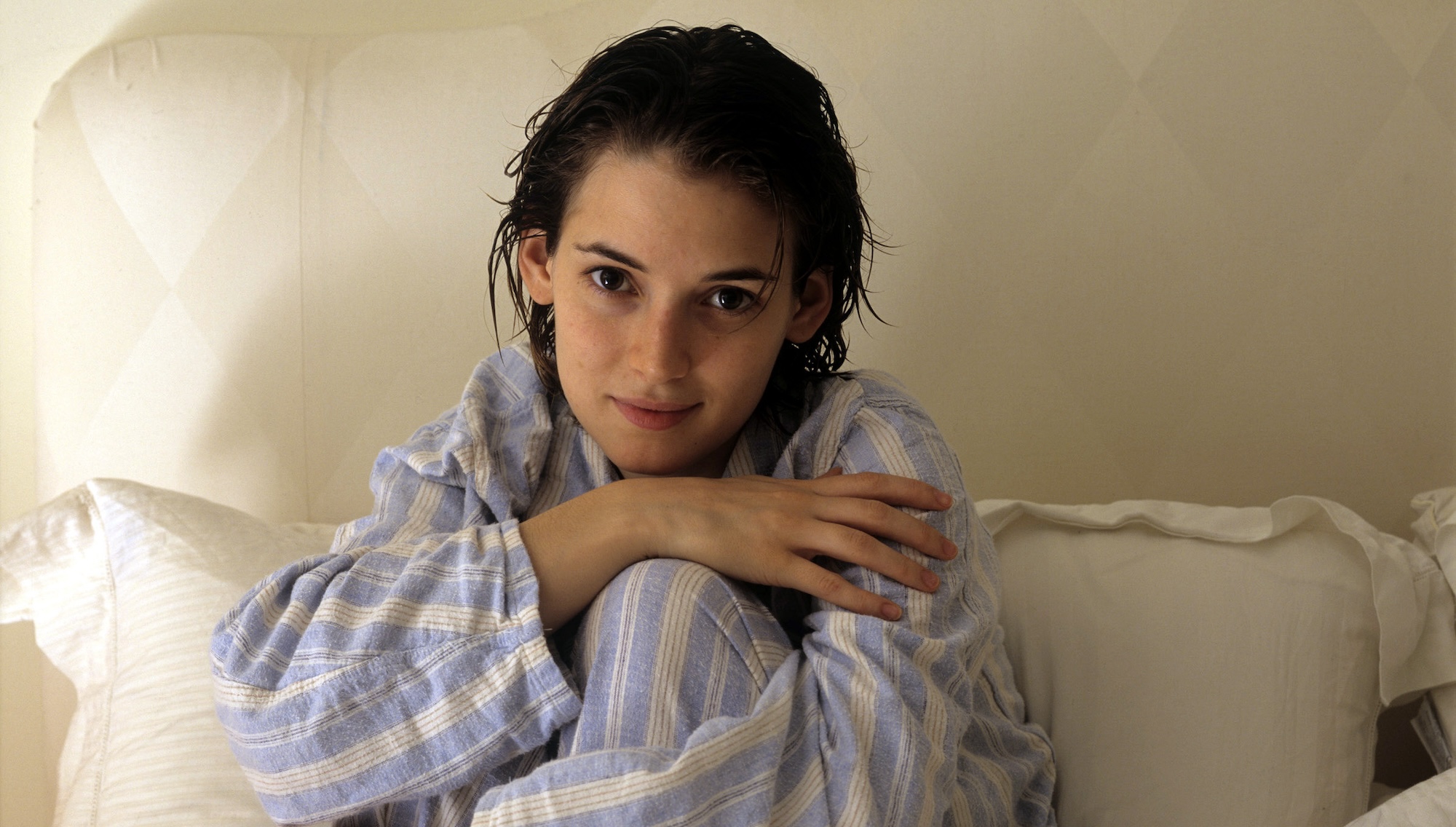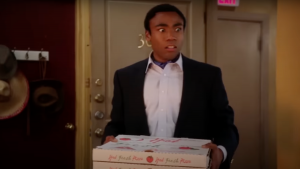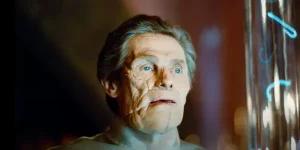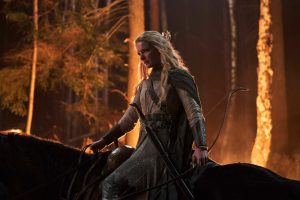
“I myself am strange and unusual.” Those words, spoken by Lydia Deetz in Beetlejuice, captured the appeal of Winona Ryder during the late 1980s and ’90s. After supporting parts in Lucas (1986) and Square Dance (1987), Ryder broke out with Beetlejuice, cornering the market on young misfits who have no place in established society. Since then Ryder’s been a constant presence in film and television, even after her heyday or so-called “Winona4Ever” era. But with director Shawn Levy casting her as distraught mother Joyce Byers in Stranger Things, and Tim Burton bringing her back for Beetlejuice Beetlejuice as Lydia, now a mom to Jenna Ortega’s next generation of Goth Kid, Ryder’s legacy as Gen X cinema icon is back in the forefront.
For those who weren’t there to experience the phenomenon, or those who’d just like to fondly recall it, these are the movies that demonstrated Ryder’s unique appeal to the strange, the unusual, and everybody else.
Beetlejuice (1988)
“I am utterly alone,” writes strange and unusual teenager Lydia Deetz in her first draft of a suicide note. She was speaking for an entire generation of misfit teens in the ’80s. From her fabulous Goth outfits, to her iconic pointy fringe, Lydia was the little weirdo that we didn’t know we needed. She’s depressed, sure, but she’s also strong, creative, clever, and brave.
Ryder was the perfect embodiment of teenage angst. She’s beautiful but unconventional, with those soulful dark eyes. Her parents are awful but with the nurturing hand of Adam and Barbara Maitland (Alec Baldwin and Geena Davis), Lydia manages to not marry Betelgeuse, excel in her studies, and finishes the film with a joyful dance with a team of dead American football players. – Rosie Fletcher
Heathers (1988)
After Beetlejuice, Ryder changed it up and became deeply, achingly cool. Veronica Sawyer is the fourth wheel of this film’s “Heathers”—the high school mean girls, the other three of whom are named Heather. Though she hangs with the A-group, Veronica secretly hates her friends, so when the mysterious JD (Christian Slater) arrives, she’s more than happy to prank them. Thing is, these aren’t pranks. JD has murder on his mind…
Heathers might be peak 20th century Winona Ryder, her hair was perfect, her clothes were cool, she’s dating the sexy bad boy, but at the end of the day manages to hang onto her integrity. Heathers is a brilliant high school satire, it was Mean Girls before Mean Girls existed, and Ryder instantly became a teen icon. Winona Forever, indeed. – RF
Great Balls of Fire! (1989)
At first glance, Great Balls of Fire! seems like an aberration in Ryder’s rise. Jerry Lee Lewis might have been shocking in the 1950s, but what could be less cool to Gen Xers than a guy who scandalized people by playing the piano really hard (except for Ben Folds, I suppose)?
Yet there’s a certain camp element that director Jim McBride brings to the proceedings, that makes Ryder’s take on Myra Brown, Lee’s teenage cousin and eventually wife, more compelling. Ryder matches the winking energy captured by future Reagan star Dennis Quaid (playing a different type of killer), making her giggling Southern schoolgirl almost transgressive. – Joe George
Mermaids (1990)
Beetlejuice Beetlejuice isn’t the only time Ryder shared screen time with a Wednesday Addams: Mermaids was the movie debut of a young Christina Ricci who would go on to play the Addams girl in the movie released a year later. At the time, this was also a change of pace for Ryder, a meaty dramatic role which won her a Golden Globe nomination.
Ryder plays Charlotte, the 15-year-old daughter of Cher’s free-spirited single mother. Charlotte is anxious and deeply religious, and fears she might be pregnant via immaculate conception after she shares a kiss with a local man. Later her desire to act out in defiance of her mother nearly results in tragedy for her younger sister (Ricci). Mermaids is a coming of age journey for Charlotte and Ryder plays her with seriousness and sensitivity. There’s room for a lightness of touch too since the movie might be best remembered for the Shoop-Shoop song released off the back of the film. – RF
Edward Scissorhands (1990)
The spiky, sardonic Goth teen from Beetlejuice may not have seemed the obvious choice to play high school cheerleader Kim in Edward Scissorhands, but Ryder had both archetypes covered. Conventionally beautiful in a long blonde wig and pastel costumes, Kim was popular, accepted, normal… everything that Johnny Depp’s outcast Edward was not on the outside. On the inside, they were just two innocent kids with cookie hearts—in love both on set and off.
There’s an honesty to Ryder’s performance as 17-year-old Kim (helped by the fact that contrary to Hollywood tradition, the actor was actually a teenager playing a teenager). Her mortification at her mother’s new houseguest gradually cedes to affection as she learns that weird doesn’t mean bad. Realizing that Edward is devoted to her in a way that her douchebag boyfriend never will be, Kim stands up for herself and follows her heart. Ryder may have been cast against type, but in this story about alienation, she made the perfect fairytale princess. – Louisa Mellor
Night on Earth (1991)
Whatever cred Ryder got from working with Burton and Lehmann, it’s hard to out-cool Jim Jarmusch in the 1990s. Having already established himself as master of American independent cinema with Stranger Than Paradise (1984) and Down by Law (1986), Jarmusch had a reputation that none of Ryder’s other collaborators could match.
Like Jarmusch’s Mystery Train from the previous year, Night on Earth is an anthology film, this time looking into the nighttime habits of people around the world. Ryder appears alongside the late, great Gena Rowlands, herself an American independent legend. In the short, Ryder plays Corky, a cabbie who drives a high-powered Hollywood exec. The short ends with Corky rejecting movie stardom, but it also cements Ryder’s place as a ‘90s star with auteur cool cred. – JG
Bram Stoker’s Dracula (1992)
Possibly the most romantic adaptation of Dracula ever, this is the story of a love that lasts the ages. Winona Ryder is Mina Murray (later Harker), whom the vampiric Vlad (Gary Oldman) believes is the reincarnation of his beloved wife Elisabeta: a medieval queen who took her own life after believing Vlad was dead.
There is crazy chemistry between Mina and Dracula (and indeed Oldman and Ryder), and Keanu Reeves’ slightly… shall we say “awkward” turn as the drippy Jonathan Harker only serves to enhance the sense that she and Vlad really are destined to be together. Ryder makes a wonderful buttoned up, turn-of-the-century woman in corsets and hats, longing to be unleashed. – RF
The Age of Innocence (1993)
Along with Bram Stoker’s Dracula, The Age of Innocence represented a major turning point for Winona, at least in the industry if not her earliest fans’ admiration. Prior to working with Francis Ford Coppola and Martin Scorsese, she was seen as a favorite of the “kidz” in the eyes of many Boomers who ran Hollywood. After starring in a blockbuster like Dracula and, more impressively, a work of burning genius like The Age of Innocence, perceptions changed. She even earned the only acting Oscar nomination in a film where she starred opposite Daniel Day-Lewis.
Ryder, and so much else about The Age of Innocence, holds up too. Scorsese reveals the ardor of a true romantic in this exquisite adaptation of Edith Wharton’s book of the same name. But despite its title, Ryder may be the heart of the film’s true, bitter irony. Dismissed by everyone, including Newland Archer (Day-Lewis) as his lovely yet vacuous wife, Ryder’s May Archer will do any and everything to manipulate her foolish husband, and thwart his dreams of running away with her cousin (Michelle Pfeiffer) due to boyish fallacies about the power of true love. Ryder’s doe eyes smother Archer and the film in kindness, pulling the rug out from under the viewer in the third act when May, like Ryder, proves she’s an idol for her age. – David Crow
Reality Bites (1994)
Coming off three period dramas in a row (Dracula, The Age of Innocence and House of the Spirits), Ryder must have been delighted to face a costume rail of casual wear and no wigs on Reality Bites. Finally! A contemporary picture about a bunch of friends who’d be just like her, if only she wasn’t stratospherically famous and on the cover of every magazine in the newsstand.
A lot of ink has already been spilled over how far this frankly pretty mild love triangle rom-com can be said to define Gen X, so let’s skip past that and get on to the real power of Ryder in Reality Bites: her hair. That may be glib, but Ben Stiller’s directorial debut stands less as a work of art than a time capsule of early-’90s style. As wannabe documentarian Leilana, caught between yuppie Michael (Stiller) and slacker Troy (Ethan Hawke), Ryder and co-star Janeane Garofalo were a walking lookbook for a generation. They were also convincing and smart, and brought writer Helen Childress’ semi-autobiographical story to life with likeable charm, even if that soundtrack deserves to be nuked from orbit. – LM
Little Women (1994)
The Greta Gerwig Little Women is wonderful, but for those who grew up in the ‘90s, or simply prefer Louisa May Alcott’s story realized in its purest form, Gillian Armstrong’s 1994 adaptation remains the definitive take. There are many reasons for that, and high on that list is Winona Ryder’s Jo March, who like many of Ryder’s most loved characters, is another outsider and iconoclast who makes her way in the world by defying social convention.
Yet there is a joy and warmth to Ryder’s Jo, as well as the film she’s in, that is missing in other interpretations, as well as Ryder’s collection of other strange and unusuals. There’s also the most pronounced sisterhood of any adaptation between a cast that also includes Claire Danes, Kirsten Dunst, Trini Alvarado, and Susan Sarandon. The sheer affection these performers have in each other’s company, and the authenticity of Armstrong’s world-building makes this irresistible, even before you add perhaps Thomas Newman’s greatest score. Throw in sizzling chemistry between Ryder and Christian Bale at his most carefree, and you understand why a whole new generation grew up heartbroken over Jo and Laurie’s unconventional ending. Ryder probably should have won the Oscar on this one. – DC
The Crucible (1996)
As this list shows, Ryder loves to play characters who don’t fit in regular society. But none of those characters match Abigail Williams, who smears chicken blood across her face during a witch ritual at the start of The Crucible.
For the most part, director Nicholas Hytner plays things straight in his melodramatic interpretation of Arthur Miller’s play, choosing to respect the work instead of giving it personal flair. While Daniel Day-Lewis is excellent as always, here as goodman John Proctor, it is Ryder who brings energy to the proceedings as Abigail, reminding the viewers that The Crucible was a work of protest before it was required high school reading. Her Abigail is also the most morally contemptible character Ryder got to play during the height of her popularity. – JG
Alien Resurrection (1997)
Even in this period of unnecessary reclamation projects, Alien Resurrection still feels like a mess. Worse, Ryder gets saddled in a thankless role as android Call, falling between fantastic takes by Ian Holm and Lance Henriksen before her, and Michael Fassbender and David Jonsson afterward. Worse, Ryder’s stuck trying to find a consistent tone between director Jean-Pierre Jeunet’s extreme visuals and screenwriter Joss Whedon’s snarky dialogue, the latter of whom was already falling into his patterns for writing his ideal nerdy “cool girl” (this one’s an android).
Like everything else in Resurrection, Ryder’s character is dialed up to the highest level. Call butts heads with Ron Perlman’s brutish Johner and stares with wide-eyed wonder at the Ripley clone played by Sigourney Weaver. Somehow, Ryder manages to thread the needle of Resurrection better than any of her co-stars, even if the movie fails around her. – JG
Girl, Interrupted (1999)
It’s tempting to look at the real interruption of Girl, Interrupted to be Ryder’s career. Director James Mangold’s movie based on the memoir by Susanna Kaysen (adapted for the screen by Mangold, Lisa Loomer, and Anna Hamilton Phelan) earned awards attention not for Ryder, but for her co-star Angelina Jolie, who won a Best Supporting Actress Oscar for her performance as sociopath Lisa.
And yet, Ryder still deserves praise for her performance as Susanna, who gets sent to a psychiatric hospital after a breakdown. Ryder doesn’t have the showier part, but she uses her wide eyes to great effect, bringing the audience into the facility and among the other patients. Even when the story gets too sensationalist, Ryder keeps things grounded in a real and believable character… which, of course, isn’t the sort of thing that the Oscars award. – JG
2000s and Beyond
Of course Ryder’s career extended beyond the 1990s. She continued to work with interesting directors, appearing in Richard Linklater’s experimental animated film, A Scanner Darkly (2006), Andrew Niccol’s prescient S1mone (2002), and Ariel Vromen’s hitman biopic, The Iceman (2012). These roles found Ryder continuing to push boundaries, moving beyond the wide-eyed outsider parts that defined her early career.
In A Scanner Darkly, Ryder hides a desperate addict under a veneer of sweetness, resulting in a vulnerability that shines through Linklater’s rotoscoping. The Iceman relegates Ryder to the role of housewife who doesn’t realize that her husband (Michael Shannon) is a contract killer.
But at the same time, Ryder kept in touch with Hollywood blockbusters—at least when they would have her. After a guest appearance on Friends as a college roommate who still carries a torch for Rachel, Ryder started doing more broad comedies. She throws herself into the part of cynical journalist who falls for Adam Sandler in Mr. Deeds (2002) and pops up in David Wain’s ribald sketch anthology, The Ten (2007). Ryder appeared as Spock’s human mother Amanda in J.J. Abrams’ 2009 Star Trek reboot and Burton’s remake of Frankenweenie (2012). Unfortunately, much of Ryder’s later career, at least before Stranger Things, is relegated as what might have been if the studios hadn’t turned their backs on Ryder for most of the 2000s.
Still, given her consistent interesting work beyond the 1990s, it’s inaccurate to say that she was cast in Stranger Things as just another example of the show winking at Gen X culture. As Levy himself told Den of Geek, Ryder’s retro appeal was “a two percent bonus.” Instead Levy explains that he “went after Winona because she’s an awesome actress who has not been given the juicy kind of roles that she excels at. We needed someone who was able to access deep, raw places, and Winona is that good an actress and it felt like the moment was right to take a shot.”
Even if Levy’s right and Ryder didn’t get the best roles of the 2000s and 2010s, it’s clear that she never lost a step, staying strange and unusual forever.
The post The Movies That Defined the Winona Ryder Generation appeared first on Den of Geek.





